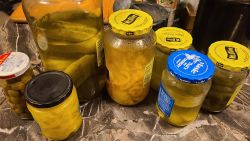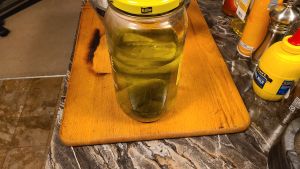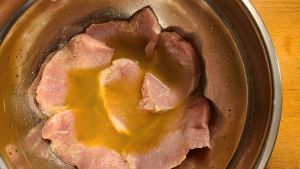Pickle Juice
This may seem kind of weird, but I save back Pickle Juice from the jarred pickles, olives, pepper rings, and other pickled foods that I buy. Why? It's great brine for lean meat like turkey, chicken, and pork.[1] Muh momma used to do this for her fried chicken and nobody could ever figure out what that zingy background flavor this brining method produced.[2]
I don't save it back all of the time, but when I know that I will need to pump up the flavor in normally dry, bland food, this is a good go-to method. Also, since most people just pour the juice down the sink after they eat their pickles, it makes me feel like I am saving the environment by not adding unnecessary vinegary green liquid to the water table.
What To Do?
Buy pickles. Buy pepper rings. Buy pickled onions. Buy sauerkraut. Mankind has been pickling just about everything for over four thousand years,[3] so you can probably find a billion different items that are pickled in a brine, are in a jar, and are located in the condiments aisle at your local grocer.
Most jarred pickles and other items come in a brine that will basically last forever if you keep it in the fridge.[4] After all, it's just water, vinegar, salt, calcium chloride, sodium benzoate (which is a preservative), alum, and polysorbate 80.
They sometimes use the food color "Yellow Nº 5" to give their pickles that traditional pickle juice color. Using pickle brands with this ingredient will give your protein a delightful greenish tinge. Try it on shrimp and freak your friends out.
Once you have purchased your pickles and other brined foods, eat them and enjoy them. Do not throw the jar full of juice out. Find some larger vessel and save back that liquid. Most chain grocers have a large "store brand" jar of huge dill pickles on the bottom shelf of the pickle section. They are always really cheap. Usually like 6 or 8 bucks for a huge jar of those old "deli style" brand of pickles.
These types of pickles are usually not very tasty, but you aren't buying the jar for that. You are buying the jar to save your pickle brines over a period of time. Also, most of the time, the jar's mouth is wide enough to squeeze a roasting chicken into the jar. Now you have a self contained brining vessel.
The Science
![]() Brining adds moisture, making it the best choice for lean proteins. Salt in the brine not only seasons the meat, but also promotes a change in its protein structure.[5]
Brining adds moisture, making it the best choice for lean proteins. Salt in the brine not only seasons the meat, but also promotes a change in its protein structure.[5] ![]()
In cooking, brining is a process similar to marination in which meat is soaked in a salt solution (the brine) before cooking. Brining makes cooked meat moister by hydrating the cells of its muscle tissue before cooking and by allowing the cells to hold on to the water while they are cooked.[6]
References
- ↑ https://www.allrecipes.com/article/clever-uses-for-pickle-juice/
- ↑ Here is some meathead's recipe: https://eatthegains.com/chicken-marinated-in-pickle-juice/
- ↑ If you make your own pickles, your results will work as well. http://fermentationpodcast.com/pickle-juice-uses-leftover-brine/
- ↑ https://www.verywellfit.com/pickle-juice-nutrition-facts-and-health-benefits-4164284
- ↑ https://www.americastestkitchen.com/cooksillustrated/how_tos/5804-brining-meat <--this link is now behind some sort of pay wall.
- ↑ https://www.scienceofcooking.com/science-of-brining.html
Baked Eggs | Clam Dip | A 75 Dollar Meal In Japan | Chef Jean Pierre | Breakfast | You Must Eat All The Eggs | Spider Goulash | Watermelon | Moleasses | Fresh Salsa | Cigarettes | Lunch | Homemade BBQ Sauce | Ramen | Brunch | Smokes | Dinner | Supper | Afternoon Tea | Doritos Ingredients | Late Night Snack | So Hi | 9 Pounds Of Onions | Hot Sauce | Microwave Oven | Blue Moon | Tomato Soup | The Destruction Of Food Processing Facilities | Rejected Mountain Dew Flavors | Self Serving Skillet | RC Cola | Poppers | Cheese Spread | Sushi | The Scoville UNIT | Burger | Brussels Sprouts | Justin Wilson | Pesto | The Waffle House Index | Pickled Garlic | The Tennis Racket | WHOPPER WHOPPER WHOPPER WHOPPER | The War On Eggs | Cereals That Are Gone | Ketchup On A Hot Dog | Stainless Steel And Garlic | Red Bull Inn | Mustard | La Choy | KFC Firelog | Domicopter | Chili Crisp | Zah | Adobo Chuck Roast | The Old Pick Nose And Eat It Switcheroo | Resiniferatoxin | La Fin du Monde | Coffee | Frank's Red Hot© | Omelette Man | Vegan | Chinese Restaurant Syndrome | Chili | Cheeses | Sausages | Chicken And Noodles | GWEET | Superman Imitation Pasteurized Process Cheese Spread | Big Brussel Sprouts | Prime Rib | Chowder | When I Feel Bad | Trout | Maytag Blue Cheese | Lazy Devilled Eggs | Bloody Mary



